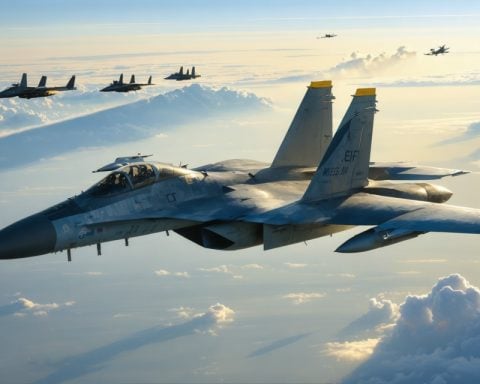- The UAE shows strong interest in Turkiye’s KAAN fighter jet project, indicating potential collaboration between the nations.
- Turkiye is advancing its fighter jet project, with the second prototype expected by the end of the year.
- Potential partnerships could involve Emirati engineers collaborating with Turkish experts, enhancing both countries’ defense capabilities.
- The ATAK 1 helicopter drew significant attention from the UAE, leading to delegations visiting Turkiye for further talks.
- The UAE’s Calidus has signed an agreement for joint development of the Hurkus training aircraft.
- Discussions on the ANKA-3 combat drone highlight possibilities for broader cooperation in military technology.
- This growing partnership signals a future of shared innovation and strategic defense alliances between the UAE and Turkiye.
Amidst the gleaming sands of Abu Dhabi, the UAE’s gaze turns towards Turkiye’s ambitious KAAN fighter jet project. At the IDEX 2025 defense exhibition, Turkish Aerospace Industries (TAI) made waves, as their innovative military technologies caught the eye of Emirati officials. The UAE’s keen interest in the KAAN signals potential collaboration between the two nations, fostering deeper defense ties across the region.
The UAE’s anticipation grows as Turkiye accelerates its fighter jet project, with the second prototype nearing completion by year’s end. TAI’s CEO, Mehmet Demiroglu, hinted at promising discussions with UAE counterparts, hinting at an impending partnership that could enhance both countries’ defense capabilities. This collaboration could soon see Emirati engineers working hand-in-hand with Turkish experts, blending expertise to push the bounds of aerial innovation.
But the KAAN isn’t the only project capturing attention. The robust ATAK 1 helicopter also enthralled the Emiratis, prompting them to send a delegation to Turkiye. The aircraft’s impressive performance fueled talks of potential joint ventures. Meanwhile, the Hurkus training aircraft has already seen UAE’s defense firm Calidus sign an agreement with TAI for collaborative development, marking another milestone in this burgeoning partnership.
Furthermore, discussions around the ANKA-3 combat drone hint at even broader cooperation. The shared interest in developing transformative air platforms underscores the UAE’s receptivity to advanced military technology and Turkiye’s prowess in the field.
This collaborative spirit embodies a promising future—where innovation knows no borders and strategic alliances forge new paths in aerospace achievements across the Middle East. The UAE’s interest in these projects symbolizes a mutual aspiration to soar higher together, redefining the region’s defense landscape.
Breaking Ground: How the UAE and Turkiye’s Aerospace Collaboration Could Transform the Middle East
How-To Steps & Life Hacks
1. Navigating Defense Collaborations: Engaging in international defense partnerships requires aligning strategic interests and harmonizing regulatory frameworks. For nations like the UAE and Turkiye, leveraging diplomatic channels and shared defense needs can fast-track collaborative projects.
2. Building Joint Ventures: Successful cooperation starts with establishing mutual goals and transparent communication. A phased approach—starting from technology exchanges to joint engineering and production initiatives—can foster long-term partnerships.
3. Innovative Design Synergies: For engineers and tech developers, collaboration enhances innovation. Mutually benefiting from each country’s strengths—such as Turkiye’s aerospace tech and the UAE’s engineering capabilities—could lead to pioneering advancements in aerial systems.
Real-World Use Cases
– Regional Defense Enhancement: The integration of platforms like the KAAN fighter jet and the ANKA-3 drone could significantly bolster regional air security, providing rapid response capabilities and advanced intelligence for better threat deterrence.
– Spearheading Technology Transfer: Collaborations are key to fostering technology transfer, allowing Emirati engineers to acquire cutting-edge skills and experience through direct involvement in Turkiye’s aerospace projects.
Market Forecasts & Industry Trends
As defense expenditures in the Middle East are anticipated to rise, strategic alliances focusing on joint development of military technology promise to drive market growth. A study by the Stockholm International Peace Research Institute (SIPRI) highlights a consistent uptick in defense spending in the region, suggesting potential for increased collaboration between the UAE and Turkiye over the next five years.
Reviews & Comparisons
– KAAN Fighter Jet vs. Competitors: Compared to the F-35 and Eurofighter Typhoon, KAAN promises modern avionics and stealth capabilities tailored for specific Middle Eastern theater demands, offering a cost-effective alternative to Western jets.
Controversies & Limitations
– Regulatory Hurdles: International defense agreements often face bureaucratic delays and geopolitical tensions. Addressing these challenges through diplomatic channels and fostering trust is crucial for seamless execution of projects.
Features, Specs & Pricing
– KAAN Fighter Jet:
– Stealth Technology
– Advanced Avionics Systems
– Estimated Cost: $80-100 million per unit (based on similar aircraft markets)
– ATAK 1 Helicopter:
– Multi-role Capabilities
– Enhanced Firepower Options
– Estimated Cost: $50-60 million depending on configurations
Security & Sustainability
The sustainability of such aerospace collaborations depends on the robustness of bilateral agreements and adherence to international arms control regulations. Experts advocate for clear frameworks that prioritize long-term security over short-term gains.
Insights & Predictions
Increased defense integration between the UAE and Turkiye is likely to set new precedents for military collaborations in the Middle East, with potential expansion into civilian aerospace innovations driven by shared technology exchanges.
Tutorials & Compatibility
Training programs and compatibility checks between Emirati and Turkish defense platforms are essential to ensure smooth operational transitions. Joint training exercises can bridge knowledge gaps and acclimate military personnel to new systems.
Pros & Cons Overview
– Pros:
– Enhanced regional security through diversified defense assets.
– Strengthening of diplomatic relations and mutual trust.
– Cost-effective access to cutting-edge technology.
– Cons:
– Potential delays due to political and regulatory challenges.
– Risk of technological dependency if diversification is not balanced.
Actionable Recommendations
– Strengthening Diplomacy: Prioritize diplomatic engagements and military attaché networks to streamline collaborative efforts.
– Joint Exercises: Implement regular joint exercises to ensure seamless integration of deployed systems and personnel coordination.
– Risk Mitigation: Establish robust contractual frameworks to mitigate risks associated with potential political shifts or economic disruptions.
For more insights and updates on defense partnerships and technological advancements, visit Turkish Aerospace Industries.







